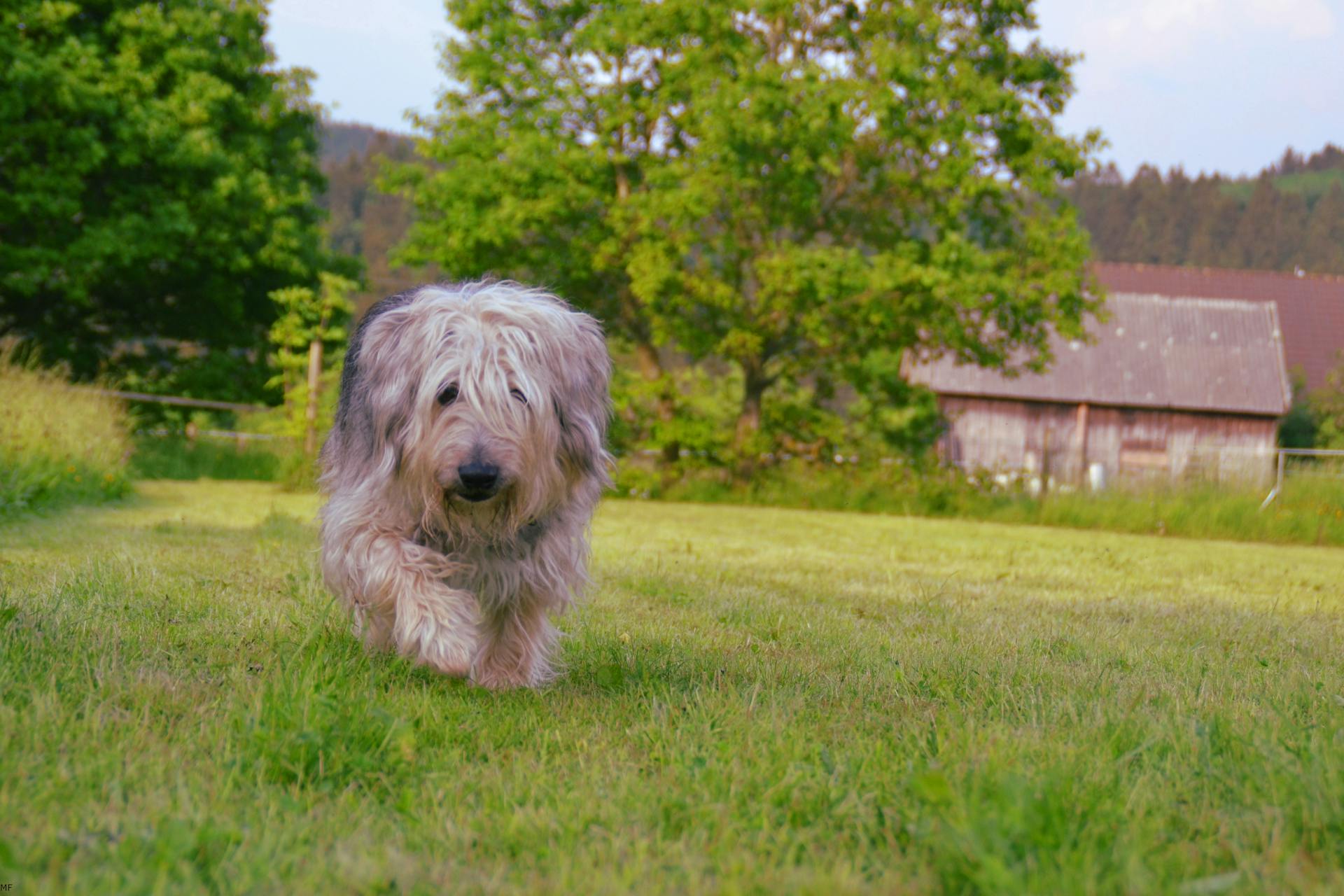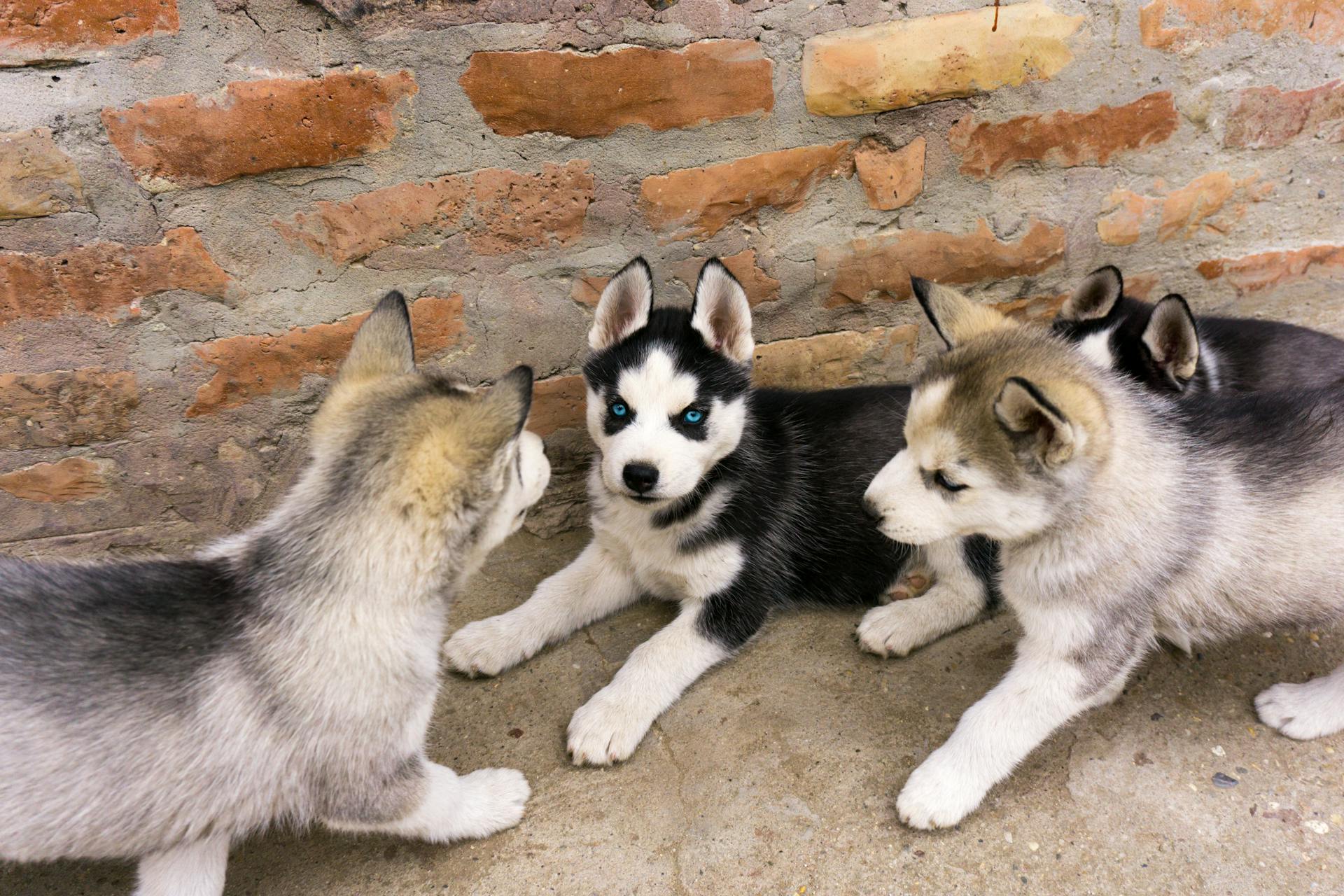
If you're looking for a compact companion that captures the essence of a Husky, you're in luck. The Alaskan Klee Kai, for example, is a miniature Husky breed that weighs around 10-18 pounds and stands 13-17 inches tall.
These tiny dogs have a similar appearance to their larger counterparts, with a wolf-like face, erect ears, and a thick coat that sheds heavily. They're a great option for apartment dwellers or those with limited space.
One thing to keep in mind is that the Alaskan Klee Kai is a relatively rare breed, so you may have to search a bit harder to find one. But trust us, it's worth the effort.
The American Eskimo Dog is another breed that's worth considering. They're a small, white dog that weighs around 10-20 pounds and stands 9-12 inches tall, making them a great fit for city living.
See what others are reading: Breeds of Dogs under 40 Pounds
Alaskan Klee Kai
The Alaskan Klee Kai is a small breed that resembles the Siberian Husky, with a striking blue or multi-colored eyes, plush double coat, and expressive face.
This breed was developed in the 1970s in Alaska, specifically to provide a smaller, companion-sized version of the Alaskan Husky.
The Alaskan Klee Kai is often called a "miniature Husky" due to its resemblance to the Siberian Husky, especially in its face markings.
They have a friendly, sweet temperament, but may not be suitable for small children who don't know how to interact with dogs properly.
Alaskan Klee Kais are high-energy dogs that need regular playtime to keep them from getting bored, and if they don't get enough exercise, they'll let you know about it.
They require frequent mental and physical challenges, just like Huskies, due to their high prey drive and curiosity.
With proper care and attention, the Alaskan Klee Kai can thrive as a beloved companion for active families with plenty of fun and stimulating activities.
On a similar theme: Alaskan Klee Kai vs Husky
Similar Breeds
If you're looking for dogs similar to huskies but in a smaller package, you've got plenty of options.
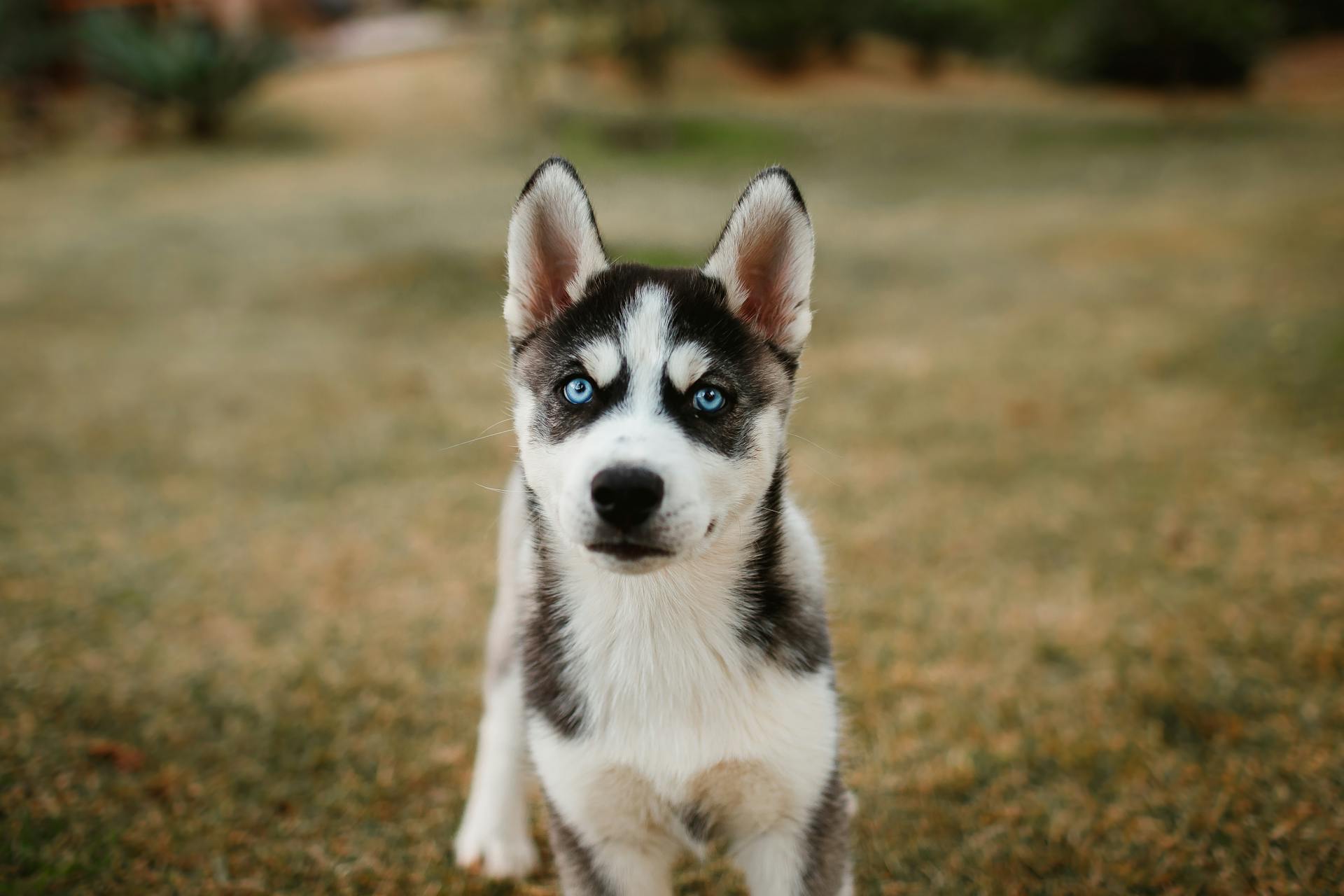
Some breeds that resemble huskies in appearance and temperament include the Shiba Inu, with its almond-shaped eyes and curled tail, and the Icelandic Sheepdog, which has a fox-like face and erect ears.
The Alaskan Klee Kai is another breed that's often mistaken for a miniature husky, due to its striking coat colors and markings. These dogs are highly energetic and intelligent, requiring plenty of exercise and mental stimulation to stay happy and healthy.
For families with children, the Alaskan Klee Kai and Shiba Inu are both great options, as they're loyal and friendly, but can be a bit rambunctious. The Icelandic Sheepdog is also a good choice, as it's highly trainable and loves being part of a family.
Here are some key characteristics of these breeds:
Miniature
Miniature Husky breeds are a great option for those who want a smaller version of the classic Siberian Husky. These dogs are active and athletic, requiring tons of exercise to stay happy and healthy.
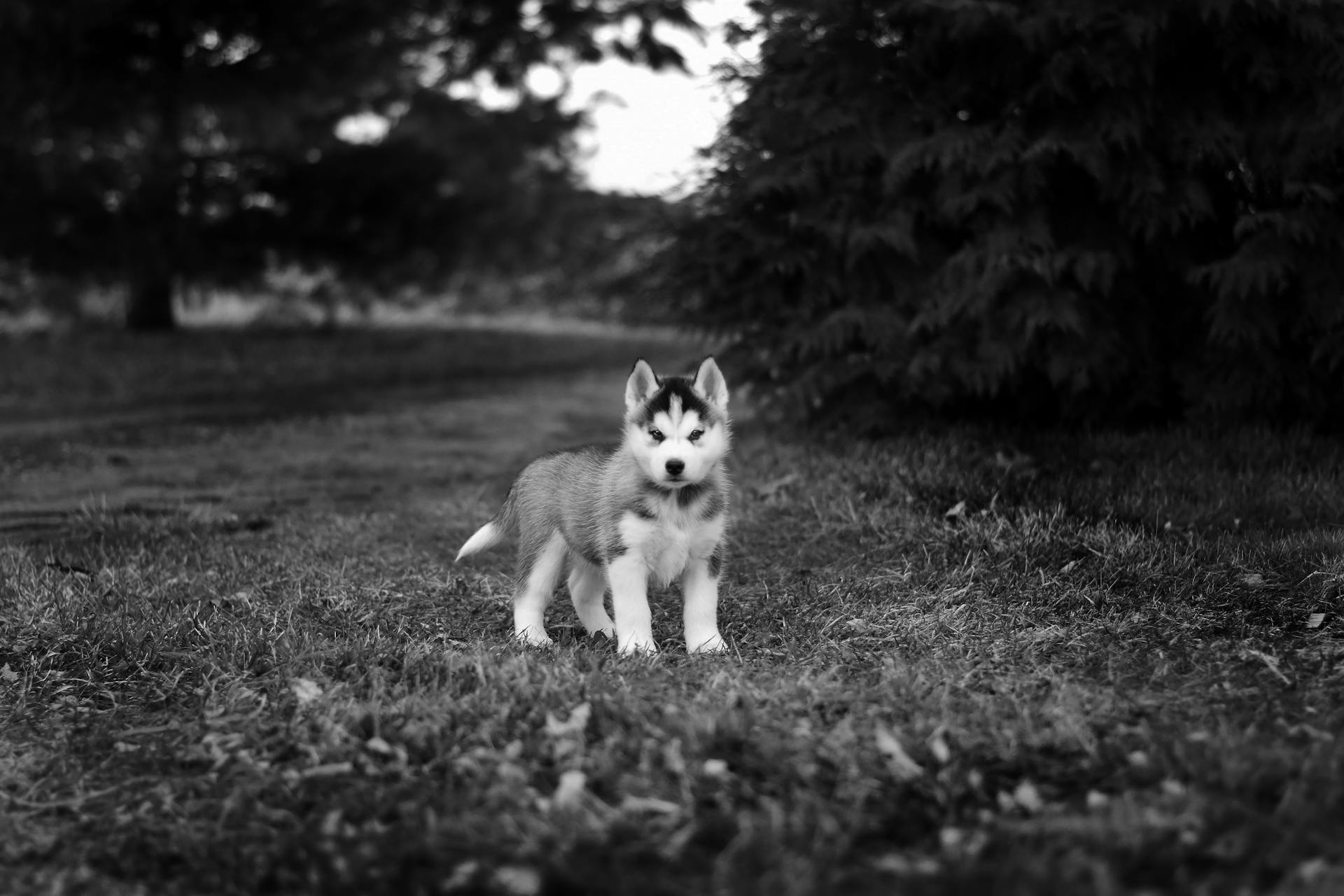
They love to run and can become destructive if not given enough stimulation, so a daily walk or playtime is a must. In fact, miniature Huskies are known to be mischievous and playful, making them a great fit for families with kids.
Here are the different sizes of Alaskan Klee Kai, a miniature Husky breed:
Miniature Huskies are also prone to certain health issues, including breathing problems, eye issues, and intervertebral disc disease. They're also known to be clingy and love being the center of attention, but they're loyal and friendly companions.
Alaskan Klee Kai vs. Siberian Breed
The Alaskan Klee Kai vs. Siberian Husky debate is an interesting one. They're both energetic and intelligent breeds that require plenty of exercise and mental stimulation to stay happy and healthy.
Daily walks, playtime, and mental stimulation are a must for Alaskan Klee Kais. They also have a thick double coat that requires regular brushing to keep it looking its best.
Discover more: Alaskan Husky Sled Dog
One of the main differences between the two breeds is their size, with Alaskan Klee Kais being significantly smaller. They're also known for being somewhat reserved around strangers, so early socialization is important.
Alaskan Klee Kais are intelligent and can be a bit stubborn, so consistent, positive reinforcement training methods work best.
Characteristics
Dogs similar to Huskies but small are known for their energetic and playful personalities. They require regular exercise to keep them happy and healthy.
Some of these small Husky-like dogs are bred to be companion animals, making them perfect for families with children. They are also great for people who live in apartments due to their minimal space requirements.
These dogs are intelligent and trainable, but they can be stubborn at times. With patience and consistency, they can learn to obey commands and behave well in public.
Alaskan Klee Kai Personality
The Alaskan Klee Kai is a friendly, sweet-tempered dog that lives to please its family.
They have a strong resemblance to Siberian Huskies, which means they can be high-energy dogs that require regular playtime to prevent boredom.
Alaskan Klee Kai are intelligent and independent, just like their Husky relatives.
They need lots of activity to stimulate their brains and prevent destructive behavior.
Teacup Husky-like breeds, including the Alaskan Klee Kai, can exhibit a range of temperaments, but they often inherit traits from their Husky ancestry, such as high energy levels and an independent spirit.
They can be affectionate and friendly with their family, including children and other pets.
However, they may also have a strong prey drive, making them unsuitable for households with small animals like cats or rodents.
If you're considering getting an Alaskan Klee Kai, be sure to teach children how to properly interact with dogs and supervise interactions between kids and animals.
This breed is not suitable for families with small children who may not know how to handle dogs gently.
Exercise Needs
Exercise is crucial for your Teacup Husky's health and happiness. They need around 30 minutes to an hour of daily activity and exercise, depending on their size.
As a Pom Pom Husky mix or a Mini Husky, they'll love activities that challenge their bodies and brains. Agility training is a great way to keep them engaged and active.
Miniature Huskies may also enjoy sledding activities like bikejoring, which is a fun way to get them moving and burning energy.
Consider reading: Pom Shih Tzu Puppies
Size and Health
When it comes to size, smaller husky-like breeds are a perfect fit for city inhabitants with limited floor space.
They need less exercise and nutrition, making them ideal for busy folks.
Their compact size means they're easier to handle, especially for first-time dog owners.
Smaller husky-like breeds are as appealing as their larger counterparts but are much more manageable in tight spaces.
Convenient Size
Small dog breeds that resemble Huskies are perfect for city inhabitants with limited floor space, requiring less exercise and nutrition.
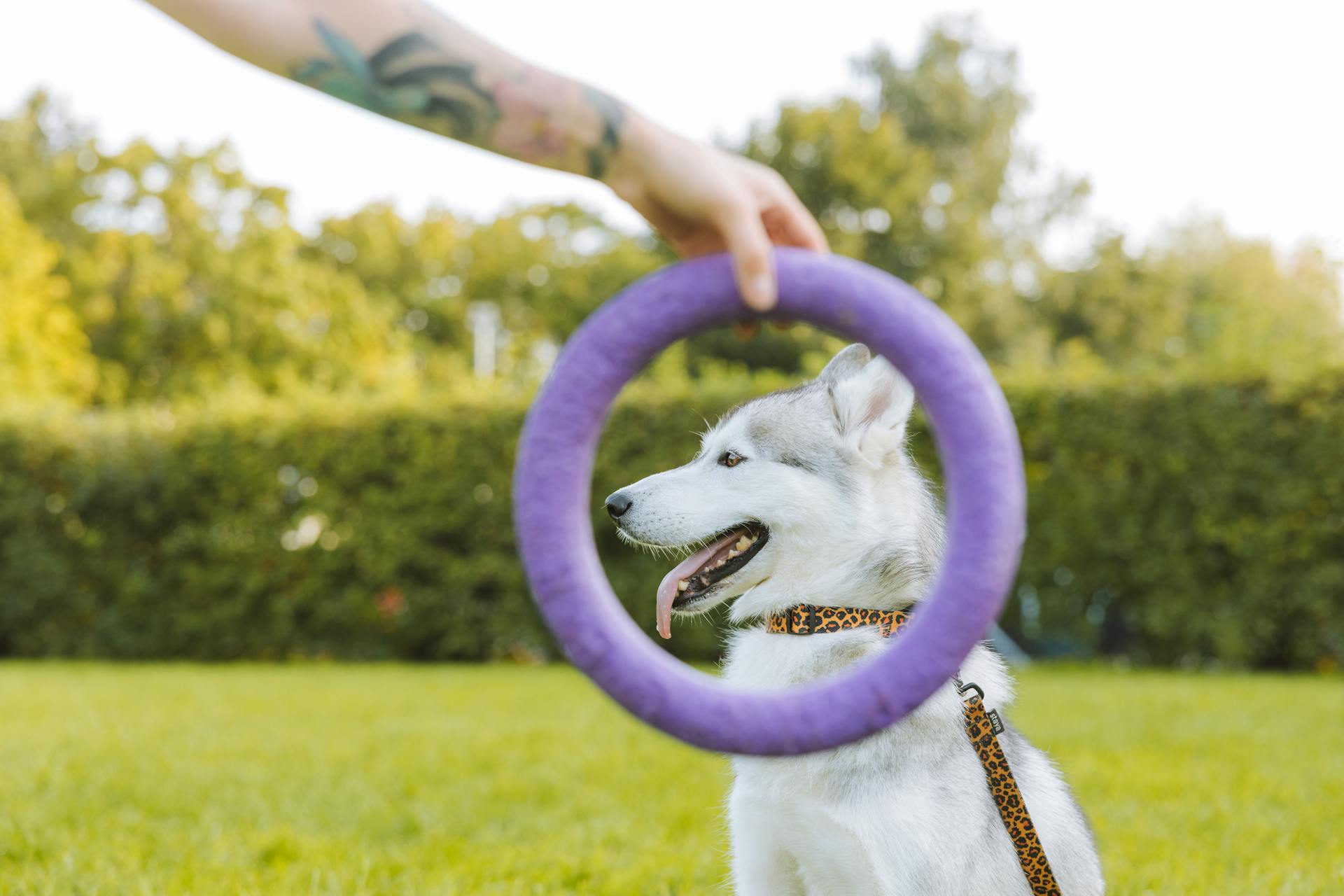
Their tiny size makes them easier to handle and care for, ideal for busy folks who want a companion without the hassle of a large breed.
Smaller Husky-like breeds need less space to run around, making them a great choice for apartment dwellers.
Their compact size also means they don't require as much food or exercise, which can be a big plus for those with limited time or resources.
In fact, some smaller Husky-like breeds can thrive with short daily walks and playtime, making them a great fit for city living.
Here's an interesting read: Great Pyrenees Similar Breeds
Adult Size
Adult size can vary depending on the breed and mix. Toy Pomeranian Husky mixes typically weigh less than 10 pounds and stand around 6 to 10 inches tall.
Miniature Huskies, on the other hand, can weigh between 15 to 35 pounds and stand around 14 to 17 inches tall.
Alaskan Klee Kais come in three sizes: Toy, Miniature, and Standard. Here's a breakdown of their typical weights and heights:
Dog Health Concerns
Dog Health Concerns can be a significant issue, especially in smaller-sized breeds.
Some of these health concerns may occur in the breeds above, teacup Huskies are not recognized or standardized.
Health problems that may come with any dog you may call a teacup Husky (or a mini Husky) include hypoglycemia, which is a low blood sugar issue that can be life-threatening if not treated promptly.
Teacup Husky-type dogs may also be prone to patellar luxation, a condition where the kneecap slips out of place.
In smaller-sized Husky-type dogs, dental problems are common, and can be caused by overcrowding of the teeth.
Teacup Huskies are not recognized or standardized, making it difficult to predict what health issues they may have.
You might like: Huskies Good Apartment Dogs
Grooming and Training
Grooming small Husky-like dogs requires regular attention to keep their thick double coats healthy and mat-free. Brush them several times a week and take periodic baths to maintain cleanliness.
Their thick coats can get messy if not groomed regularly, so be prepared to commit to regular brushing sessions.
Their independent nature makes trainability a bit of a challenge, but with patience, consistency, and positive reinforcement techniques, they can still learn basic commands.
Training and Socialization
Training your Teacup Husky-like breed requires patience, consistency, and positive reinforcement techniques.
Early socialization is crucial for shaping a well-behaved and obedient dog. Huskies generally have an independent nature and can be somewhat stubborn, making them less inclined to follow commands strictly for obedience.
With regular mental and physical exercise, you can prevent boredom, which can manifest as howling, digging, roaming, or excessive barking in these intelligent and active dogs.
Individual temperament and trainability can vary within a breed or mixed breed, so it's essential to use proper training techniques and provide regular exercise to meet their needs.
Huskies are not the most obedient breed, ranking 74th in obedience and working intelligence according to Dr. Stanley Coren's ranking. However, they often display exceptional problem-solving skills and can be clever escape artists.
Proper training and socialization can help create a well-behaved pet, but it's not a guarantee. Some Teacup Husky-like breeds, such as the Pomsky or Toy Alaskan Klee Kai, can exhibit a range of temperaments and varying levels of intelligence and trainability.
For more insights, see: Training a Small Dog
Grooming Needs
Grooming your dog regularly is essential to keep them clean and healthy. Brush your dog several times a week to prevent matting and tangling of their thick double coat.
Huskie-like dogs require frequent grooming to keep their coats healthy and mat-free. This can be a time-consuming process, so it's essential to be committed to regular grooming sessions.
Brushing your dog regularly can help prevent matting and tangling, but it's also crucial to give them a periodic bath to maintain cleanliness.
Other Small Breed Options
The Swedish Vallhund is a small breed that shares some common traits with Huskies, including their compact bodies and wedge-shaped heads.
Their friendly and affectionate nature makes them loyal companions for families and individuals alike.
In the past, Swedish Vallhunds were used to herd cattle, which has left them with a strong instinct to control movement.
This means that they may try to herd their family members or other animals, which can be both amusing and endearing.
The Icelandic Sheepdog is a small breed that bears a striking resemblance to the Siberian Husky, with their fox-like faces and erect ears.
They have a friendly and outgoing nature, and adore human companionship, thriving on being part of a loving family.
Icelandic Sheepdogs are highly trainable and have excellent problem-solving abilities.
Their thick double coat enables them to withstand harsh climates, similar to Huskies.
The Finnish Spitz is a small breed that shares some characteristics with Huskies, including their pointy ears and curled tail.
They have a strong prey drive and are excellent hunters, requiring daily exercise to keep them happy and healthy.
Finnish Spitzes are known for their distinct vocalizations and ability to "sing".
The Shiba Inu has a slightly different appearance than the Siberian Husky but still shares some similarities, with their almond-shaped eyes and curled tails.
They have a spirited and independent nature, and are incredibly loyal to their families but can be aloof with strangers.
You might enjoy: Huskies or Huskys
Factors for Choosing a Small Dog
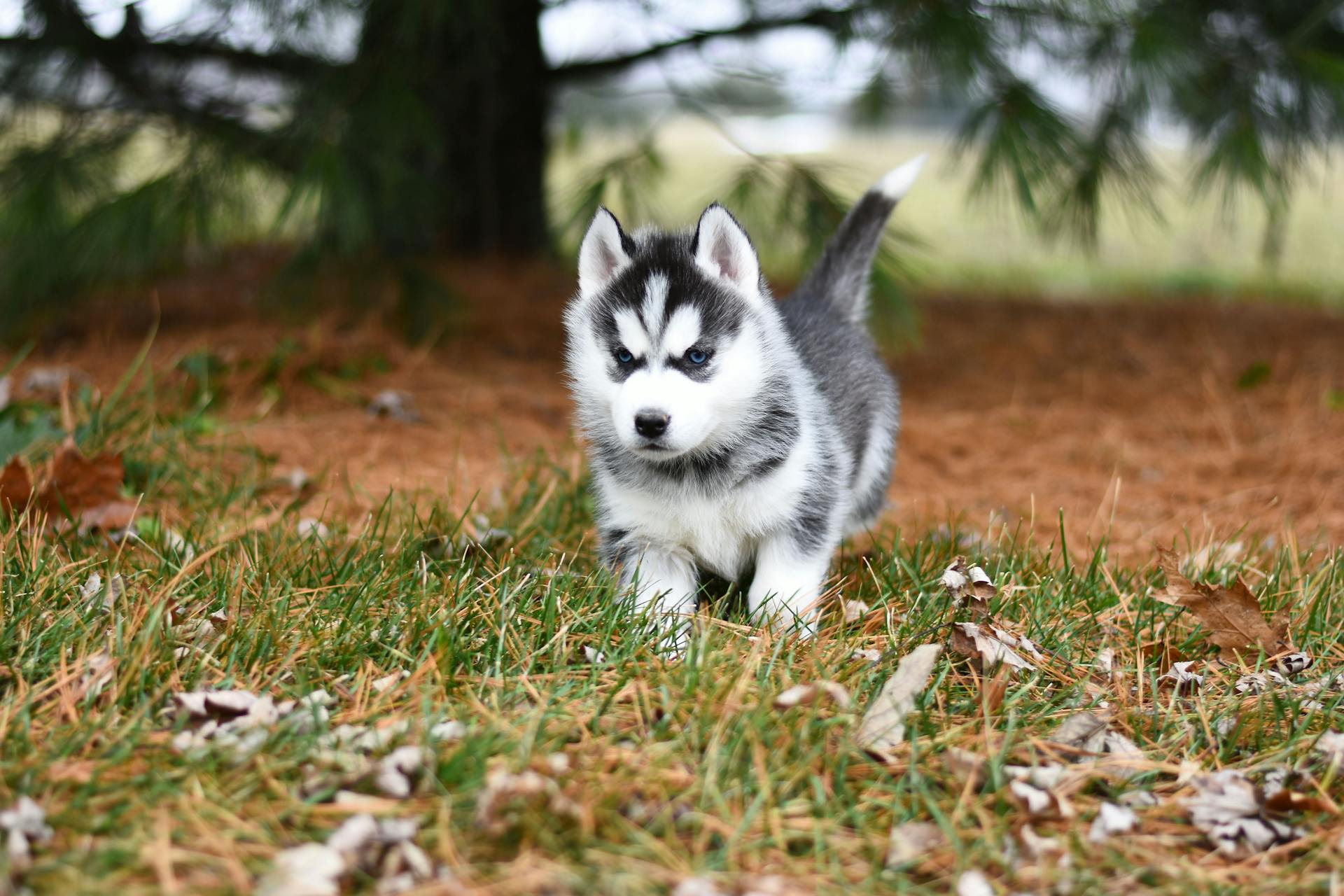
Choosing the right small dog breed can be a daunting task, but considering its size is a good place to start. A miniature Siberian Husky or a small dog with similar traits may not be the best fit for every family.
Size is a crucial factor to consider, as it directly affects the amount of space and exercise your dog needs. Your home's size and layout should be taken into account when choosing a small dog breed.
Providing a loving home to your dog is more important than choosing a specific breed. Your dog's temperament is shaped by its upbringing and care, not just its breed.
Temperament is another key factor to consider, as it determines how well your dog will interact with you and your family. A little breed research can help you find a small dog with a temperament that suits your lifestyle.
Your Huskie-like puppy will become a family member with love and patience, so it's essential to consider the care and attention it will require.
A Suitable Home
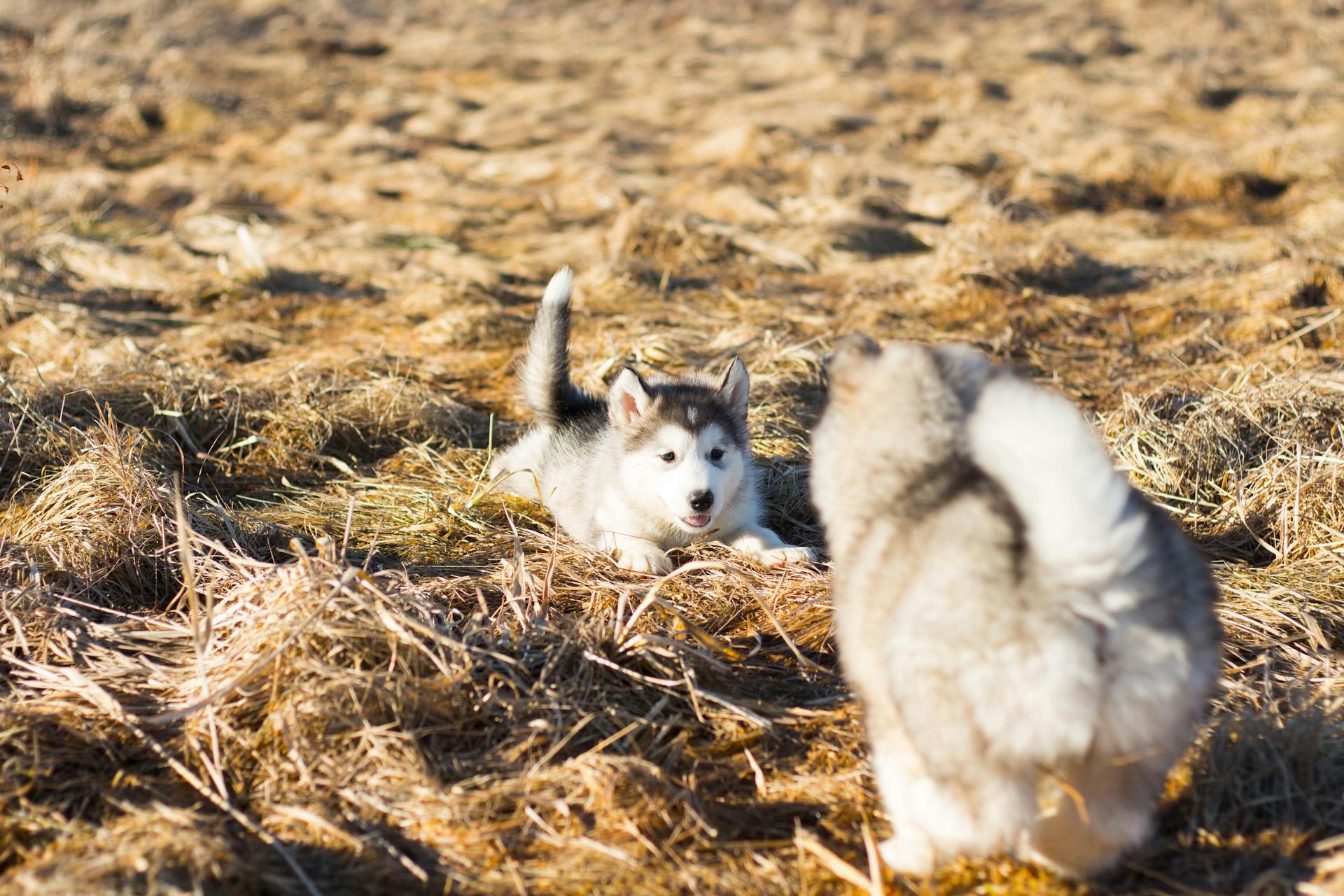
A suitable home for a small dog similar to a Husky is crucial for their happiness and well-being. These dogs require a non-allergic home environment.
If you're prepared for plenty of grooming and shedding, you'll be a great fit for one of these dogs. They need regular grooming to prevent matting and tangling of their fur.
A relatively active home is ideal, but smaller dogs like the teacup Husky can do fine with a daily walk and some playtime. However, they do need some exercise to stay happy and healthy.
If you have a multi-pet household, a small Husky-type dog can thrive with the company. Just be careful to introduce them slowly and under controlled circumstances to avoid any conflicts.
Families with older children are generally a good match for these dogs, but they can also do well in single or multiple adult households. With proper care and attention, they can make wonderful pets.
See what others are reading: Do Small Dogs Need Small Breed Food
Comparison and Options
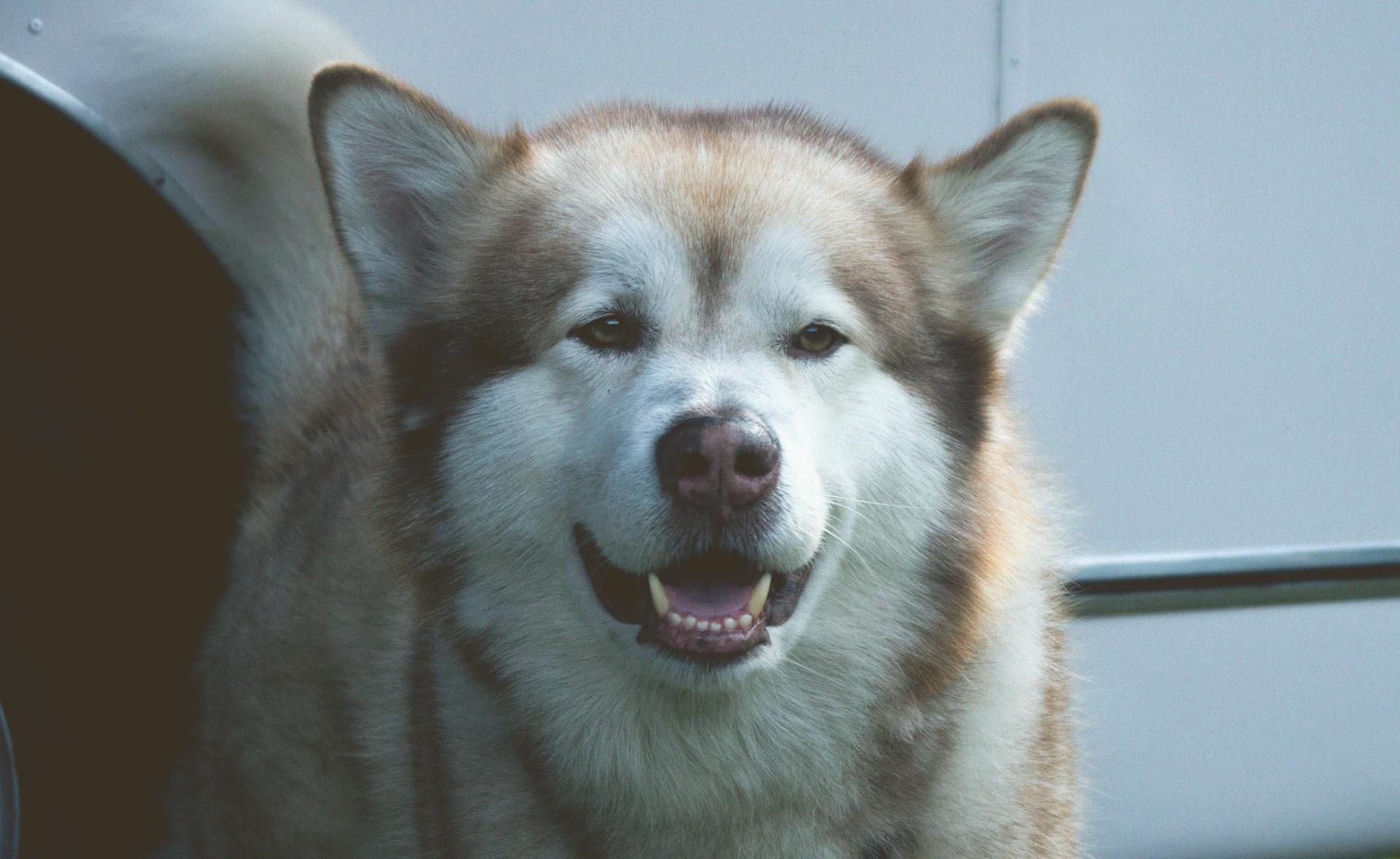
If you're looking for a small dog that captures the essence of a Siberian Husky, consider the Swedish Vallhund's friendly and affectionate nature, making them loyal companions for families and individuals alike.
Their herding background from viking times has left them with a strong instinct to control movement, which can be amusing and endearing, but also means they may try to herd their family members or other animals.
The Icelandic Sheepdog is a great option if you want a small breed with a thick double coat that can withstand harsh climates. They're also highly trainable and have excellent problem-solving abilities.
Their friendly and outgoing nature makes them adore human companionship and thrive on being part of a loving family. Icelandic Sheepdogs are perfect for active individuals or families with older children who can keep up with their abundant energy.
The Finnish Spitz has a strong prey drive and is an excellent hunter, requiring daily exercise to keep them happy and healthy. Their spirited nature makes them an ideal choice for active families or individuals.
Shiba Inus are incredibly loyal to their families but can be aloof with strangers, making them a great fit for those who want a dog that's loyal but not too clingy. With the right training, they excel in activities like agility and obedience.
Check this out: Are Husky Dogs Friendly
Featured Images: pexels.com

